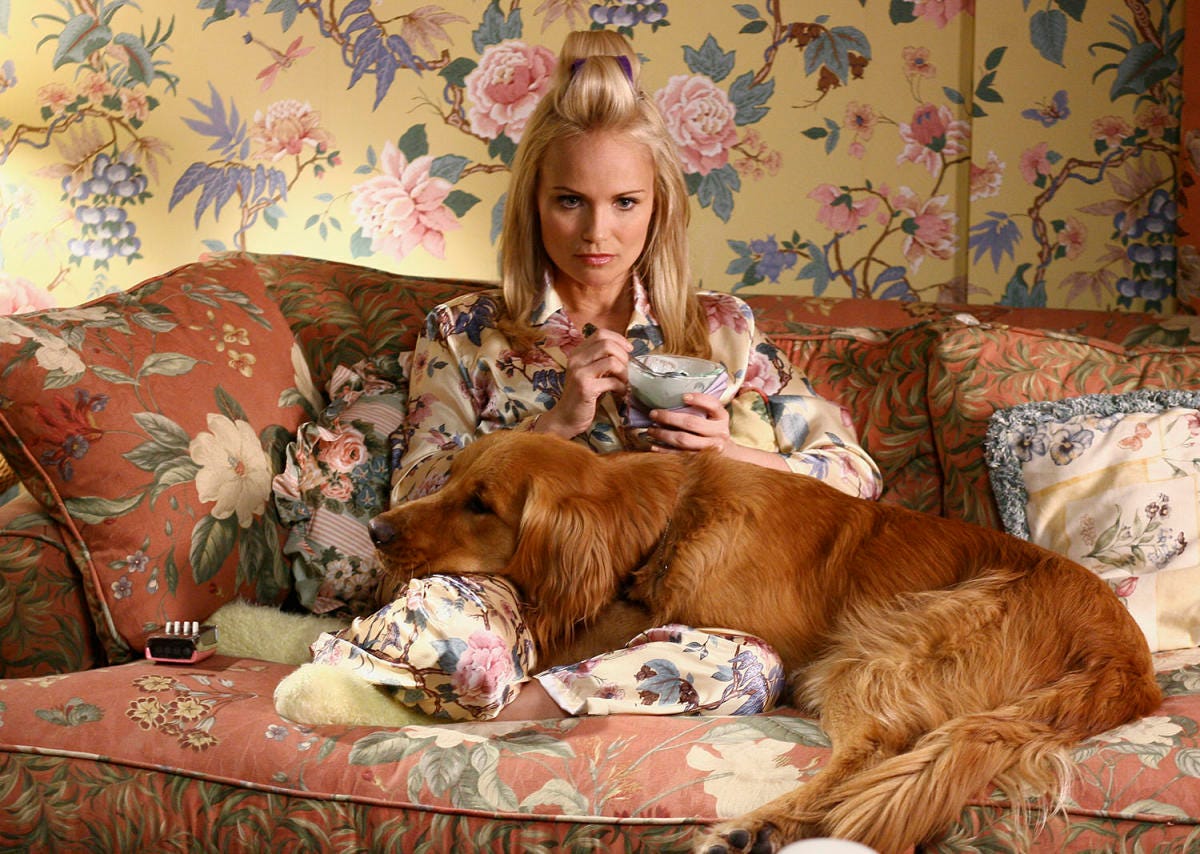A pie maker with the power to bring people back from the dead, a girl called Chuck, a knitting private detective, Kristin Chenoweth: these are the core elements of the short-lived, but much beloved, ABC series Pushing Daisies. Like most media I consumed before I was old enough to have any real sense of agency, I don’t have a clear memory of how this show became a part of my cultural makeup. It just appeared and was gone almost as soon as it arrived. Though only on the air for twenty-two episodes over two seasons between 2007 and 2009, we resurrected the show again and again on DVD. First rented from Netflix in slippery paper sleeves gingerly plucked from our mailbox like a precious artifact, then freed from their plastic hardcover case once we’d purchased both seasons, we returned to the enticing world of the show countless times. In preparation for this, I rewatched it on Max, where both seasons are available to stream. Times have changed, but the forensic fairytale is as endearingly delightful as ever. For a show about death and murder, Pushing Daisies is lousy with whimsy, something that set it apart from its peers at the time and from the current slate of television offerings today.
Looking back, it feels so improbable that the show got made at all in the context of our current pop cultural landscape. It possessed such a specific visual aesthetic, a cast full of talented actors but few stars, and no previously existing IP to bolster interest. It’s unlikely the show would get greenlit today. It feels firmly planted in its own universe: a fully formed, candy-coated world full of vintage cars and fashion, sets cluttered with quirky knick knacks, and theatrical landscapes. It existed out of time, occupying a world wholly its own. And yet, for all that made it different, it was very much a product of its time.
To quote the show, the facts are these: Pushing Daisies was created by Bryan Fuller (Dead Like Me, American Gods, Hannibal) and executive produced by Bary Sonnenfeld (The Addams Family, Men in Black). Fuller made his start in television writing on Star Trek series and spin-offs before creating his own original series, which all possessed a sly and morbid slant, with a healthy dose of camp. Sonnenfeld rose to prominence as a director after a successful run as a cinematographer, going on to helm two film franchises that defined the 90s/early 00s.
For the uninitiated, the show follows Ned (a dreamy Lee Pace) - a young pie maker who can bring people (and any living thing) back to life by touching them. Like any fairy tale gift however, there is a catch, as the show’s narrator - the iconic Jim Dale, who you may also remember as the narrator of the Harry Potter books- explains to the viewer at the top of every episode. Ned can bring anything back to life by touching it once, but if he touches it again, it is dead forever. And, if he allows someone to live longer than a minute after bringing them back to life, the universe settles the score, and someone else drops dead in their place. Ned supplements his pie-related income by teaming up with private Detective Emerson Cod (a deliciously droll Chi McBride), the only other person who knows his secret. Together, they solve murders by bringing the victims back to life for one minute to ask them who killed them, and upon solving the case, split the reward. In the pilot, Ned is reunited with his slain childhood sweetheart Chuck (the luminous Anna Friel) at her own funeral, and on impulse decides to keep her alive, setting the rest of the series in motion.
Though the episode-to-episode business of the series mimics a case of the week procedural, at its heart, the show is an unconventional love story, rife with subtle notes of queerness, (Bryan Fuller has been openly gay for some time). Lovers Ned and Chuck can never touch one another, nor can they reveal the exact nature of their relationship without revealing both their secrets. The show is packed with a Wizard of Oz-like color palette, spontaneous musical numbers, and an unabashed lack of traditional masculinity. Every blunt edge of our world is softened in this one, allowing the show’s characters to be seeped in sentimentality. But it balances itself out with an ever-present sense of the fragility of life, built on a foundation of its own contradictions. It is a funny and charming show about death, after all. Though sweet, the show is never saccharine. It’s a show about love, loss, what it means to be an outsider, and the joys of letting someone into your heart - even if you know they are bound to break it. It earns its whimsy through pathos and, as a result, its ebullience never feels trite or strained. Instead, it's something you want to savor. It’s comforting and heartbreaking, transporting and achingly familiar, like one of the pies its protagonist fashions. Rising into the mainstream at probably the only time it could have on American television, it was both a product of the world it came into and too precious to last there long. Its idiosyncrasies are what make the magic of the show so enduring, even if that’s what made its initial success so brief.
Pushing Daisies arrived just after the advent of HBO and premium cable programs such as The Sopranos and Sex and the City, but just before the “golden age of television” ushered in by high-brow and higher budget dramas like Breaking Bad (premiering the year after), Mad Men (which premiered the same year) and Game of Thrones. As a comedy, the show’s humor is oddly placed between the sweet and the morbid, but throughout all the whizzing dialogue and twee character bits, there is not one ounce of insincerity. We were only two years into the run of shows like The Office, and the sardonic, winking sarcasm of the mockumentary had not yet wrung all earnestness out of American television. This was a window of time where networks took risks on quirky, offbeat comedies, when family-friendly didn’t have to mean sanitized and bland, where different and weird could be celebrated, albeit briefly, and Pushing Daisies squeezed into its time slot on Wednesdays at 8pm to much critical acclaim. But from the outset, the show was plagued by bad luck. Production of the first season was cut short by the 2007 Writers' Strike, truncating the first season to nine episodes. Though quickly renewed for a second season, the ratings dipped and ABC flinched, canceling the show part way through the airing of the second season.
Unlike some other off-beat fan favorites of the era like Arrested Development, Pushing Daisies has never gotten a reboot, a spinoff, or a film. Several attempts have been made to bring the story back (there’s a Pushing Daisies comic out there, and much buzz about a reboot or mini-series over the years), but never anything that really aimed to recapture what was lost. It arrived in an era where niche shows could find mainstream audiences and now lingers in a time where there is so much “content” (which can feel like a dirty word these days, sullied by corporate interests) that everything is niche. Would it continue to stand as such an adored vestige of the pre-peak tv era if it had been brought back to life in this gluttonous streaming boom? Or would it only serve to disappoint its many fans, falling short of what we remember it to be? If we’ve learned anything from this period of overwhelming output in television and film, it’s that reunions aren’t always sweet. Audiences are quickly tiring of having every successful film or franchise from our pasts hollowed out and repackaged into a sad approximation of what made them special to begin with (see: all the Disney live-action remakes). More and more, people are craving something new and original, not a new version of something original. The trouble is, in this post-pandemic time now mired again in strikes and upheaval, the powers that be are much more reticent to let artists be...artistic. Preferring to mass manufacture content that capitalizes on our nostalgia instead of investing in stories that future generations can be nostalgic about. As much as I adore Pushing Daisies, I can’t say that we would be better served in having another slice of that world, today. Nostalgia is a tricky thing, and not always a reliable way to capture a viewer's attention. It’s a state of being rooted in memory, in the ephemeral. The more we try to recapture that moment, that feeling, the faster it slips through our fingers. In short, not everything needs to come back from the dead. The show will always, or at least for now, be there to revisit in its original form, as sweet as we remember.
This piece was written during the 2023 WGA and SAG-AFTRA strikes. Without the labor of the writers and actors currently on strike, the series being covered here wouldn't exist.







Beautifully-written and so true about the current era of movies and TV shows.